1. Anchor moth
Pterodecta felderi Bremer
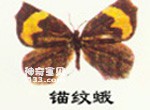
Insects of the family Anchoridae are active during the day and look like butterflies. A famous taxonomist once mistook an anchor moth with damaged antennae for a butterfly. There are about 50 species known in the world, most of which are distributed in Southeast Asia and northern Oceania. There are more on the Pacific islands than on the mainland. They often fly in groups, either on the grass and leaves, or drinking water on the roadside.
Wingspan 28-34 mm. It is tan in color, with an orange-red anchor pattern on the forewings, as well as on the back of the wings, but the base is an orange triangle with two small oval spots on it. The back of the hind wings is also orange-yellow and orange-red, covered with scattered lines. Adults overwinter.
Host: Tridentium fern.
Distribution: Northeast, North China, Hubei (Yichang, Changyang), Sichuan, Tibet (Chayu), Taiwan; Japan.
2. Bird-eye giant silkworm moth
Salassa lola Westwood
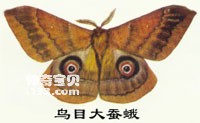
Wingspan 75 mm. The body is rusty red, the apex of the forewings is pointed, the outer edge is curved, and there are purple-pink triangular spots on the inner side of the apex; the inner line is pink-brown, the middle line is reddish-brown with white spots in between, the outer line is brown and curved, and there are brown in each vein between the outer line and the middle line. Horizontal bars, rear corners obtusely rounded. The color of the hind wings is lighter than that of the forewings. The middle line is brown with white spots, the outer line is brown, and there is a bird's-eye-shaped spot in the middle chamber. The middle of the eye spot is black and there is a white circle outside. The outer edge of the white circle is ocher red, and there is a large black circle outside.
Distribution: Tibet (Nyalam).
3. Cloud ruler moth
Buzura thibetaria Oberthur
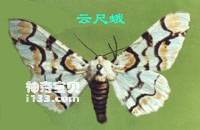
The base of the wings is white with thick black stripes, and there are light yellow spots on the outer edges of the front and rear wings; the male moth's antennae are serrated and the female moth's antennae are filamentous; there are black horizontal stripes on the abdomen, and there are yellow hairs at the end of the abdomen.
Distribution: Central China, West China, Yunnan, Guizhou, Sichuan, Zhejiang and other places.
4. Stone fence moth (alias: Stone fence moth)
Phragmatobia flavia(Fuessly)
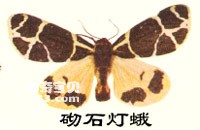
The female wingspan is 65-72 mm. The head and chest are black, with a yellow band in front of the neck plate, and a yellow triangular spot in front of the outer side of the wing base. The abdomen is yellow, the base of the back is black, there is a black longitudinal band in the center of the back, and the end of the abdomen and the ventral surface are black. The forewings are black; the inner line is yellow-white, and there is a yellow-white band in the middle chamber connected to the base of the wing; the front edge from the inner line to the outer line is yellow-white, and the rear edge has a yellow-white edge from the inner line to the hip angle; the outer line is yellow-white; the margins are Yellowish white. The hind wings are yellow with black transverse veins. The subterminal line is a broad black band with a break in the middle. The old fever larvae are black with grayish-yellow hairs, dark warts, and white tips on the bristles. They hide during the day and feed at night.
Host: Cotoneaster.
Distribution: Hebei, Inner Mongolia, Xinjiang; Europe, Siberia, Mongolia.
5. Demon Eyed Night Moth (alias: Jade Pincer Demon Eyed Night Moth)
Erebus crepuscularis L.
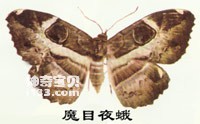
Body length 26-28 mm; wingspan 86-90 mm. The head and chest are brown, and there are white hairs on the back chest. The abdomen is grey-brown, with black horizontal stripes on the back of the first segment and white horizontal stripes on the back of segments 2-4. The forewings are brown, the inner line is black and curves outward, and the inner side is slightly white; the kidney stripe has an ocher black edge, and the rear end is bidentate. The midline is black, and the outer side is lined with white. A semicircle goes around the kidney stripe and forms an inner line near the base of the 2 veins. The teeth are convex, then extremely inclination; the outer line is black, the outer side is lined with white, the middle is zigzag or slightly convex, the subterminal line is white, irregularly wavy, there is a row of black lines on the outer side, the inner side of the front and rear ends are black, and there is a white spot on the front end . The hind wings are brown, the inner line is black, the outer side is lined with white, the middle line is white, and thinly wavy; the subterminal line is black, irregularly wavy, and the inner side is lined with intermittent white.
Distribution: Hubei, Jiangxi, Sichuan, Guangdong; Japan, India, Sri Lanka, Myanmar, Singapore, Indonesia.
6. Spodoptera radiata
Apsarasa radians Westwood
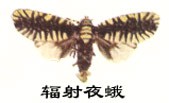
The body length is about 20 mm; the wingspan is about 49 mm. The head and chest are blue and black, there are pink and yellow spots on the lower edge of the first segment of the lower lip and the front and rear ends of the second segment, there is a pink and yellow stripe above the forehead, there are pink and yellow stripes on the neck plate and chest and back, and there are pink and yellow spots on the feet; The abdomen is blue-black, with pink-yellow spots on the back of several basal segments, the anal hairs are pink-yellow (the female moth is blue-black), the abdomen is pink-yellow, and there are blue-black spots on the sides (the female moth is blue-black, with pink-yellow spots on the sides); the forewings The background color is pinkish-yellow, with a blue-black rod-like strip in the middle, with many radiating strips of the same color. There are 10 stripes on the front line, 6 stripes on the outer edge, 6 stripes and 1 patchy spot on the rear edge, and 4 pink stripes on the front edge of the strip. Yellow spots, one pink-yellow spot in the middle of the trailing edge, and 4 gray-blue wavy lines on the outer half; the base half of the hind wing is brown-black, the front edge and outer half are pink-yellow, and there are 3 black vertical stripes.
Distribution: Guangdong, Taiwan; India, etc.
7. Feline silkworm moth
Salassa thespis Leech
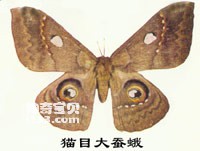
Wingspan 110-120 mm. The body is brownish-red to yellowish-brown, with ocher-red hairs on the back and chest, and reddish-brown and yellowish-brown rings between the segments on the abdomen. The forewings are brown with scattered yellow scales, and the baseline is pink and white; the midline is composed of a rusty red horizontal band and translucent white spots, with a large slope; the outer line is brown and tooth-shaped and is more vertical; the sub-outer edge line is rusty yellow and not very obvious; The corners are wide and obtuse; there are larger pink-green tadpole-shaped spots in the middle chamber, and there are black edges on the outer and upper edges of the spots. There are long brown-yellow hairs at the base of the hind wings, the inner line is pink and white, the middle line and outer line are brown and wavy, and there is a large spot in the middle chamber that looks like a cat's eye. Half of the spot is translucent tadpole-shaped, the other half is black, and there are white and brown spots on the periphery. There are apricot-yellow borders around the black circles and spots, a black eyebrow-shaped half-moon ring on the upper side, and a horizontal band composed of translucent dots on the outside of the spots.
Distribution: Shaanxi (Qinling), Fujian, Hubei.
8. Chinese Tiger Foot Moth
Xanthabraxas hemionata Guenee
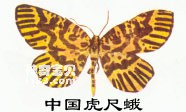
The body color is bright yellow with black spots, the front and back of the wings have the same color pattern, the inner and outer lines are wavy, there are broken black spots in the center, and there are radial stripes outside the outer lines. This is a specialty of China and a forest pest.
Distribution: North China, Central China, West China, East China.
9. Yellow borer
Vitessa suradeva Moore

The wingspan is 46 mm for males and 52 mm for females. The head and chest are golden yellow, the third segment of the lower lip barbel and the antennae are black; there are pairs of black spots with metallic flash on the chest, neck piece and collar piece; there is a black spot on the back of the middle thoracic segment; the base of the forewing is golden yellow and there are 2 black spots. , two square front and middle spots, the middle area is gray, there are two zigzag spots on the lower side of the front edge, there are oval white spots on the other side, the outer area is black, and there are white lines on the wing veins. The hind wings are white, and half of the outer edges of the wings are blue-black; the edges of the front and rear wings are gray.
Distribution: Hainan Island; India, Sikkim, Sri Lanka, Myanmar, and Indonesia.
10. Grimace Hawkmoth
Acherontia lachesis(Fabricius)

Wingspan 100-125 mm. There are skull-shaped markings on the back of the chest and large gray-white spots above the eye spots. The abdomen is yellow, with black horizontal bands between each segment; the back line is bluish-green and wide, covering the entire back after the fifth abdominal segment. The forewings are black, with tiny white spots and yellowish-brown scales interspersed; the inner and outer transverse lines are composed of several wavy lines of different shades, there are larger dark brown spots near the top corners, and there is a small gray-white spot in the middle chamber. The hind wings are yellow, with three broad black horizontal bands on the middle, base and outer edge, and a gray-blue spot near the rear corner. One generation occurs every year and overwinters as pupae. Adults appear in July.
Host: Solanaceae, Leguminosae, Oleaceae, Bignoniaceae, Lamiaceae and other plants.
Distribution: Guangdong, Guangxi, Yunnan; Japan, India, Sri Lanka, and Myanmar.
11. Spodoptera exigua
Speiredonia retorta L.
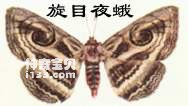
Body length 21-23 mm; wingspan 60-62 mm. The head and chest of the male moth are dark brown and purple; the base of the lower lip is red. Most of the back of the abdomen is dark brown, and the ends and ventral surface are red. The forewings are dark brown and purplish, the inner line is black, the rear part of the kidney stripe is enlarged and convoluted, and the edges are black and white; the outer line is double black, "〈" shaped, and the two lines are wide apart; the subterminal line is double line black and wavy, and the terminal line is double line. Black and wavy; there is a faint white line from the top corner to the kidney lines. The hind wings are dark brown, the terminal area is grayer, the midline and outer line are black, and the subterminal line is double black brown. The head and chest of the female moth are brown, with light ocher yellow on the back of the chest; most of the back of the abdomen is dark brown with light ocher yellow horizontal stripes, and the ends and ventral surface are red. The forewings are light ocher yellow and brown; there are 2 dark brown diagonal stripes on the inner side of the inner line and 1 dark brown wide diagonal stripe on the outer side. The color of the hind wings is the same as that of the forewings. The inner line is double black and thick, the middle line is black and the outer side is lined with light yellow. The subterminal line is double black, wavy, the inner line is thick, and its inner edge is straight.
Host plant: Albizia julibrissin.
Distribution: Liaoning, Jiangsu, Zhejiang, Hubei, Jiangxi, Sichuan, Fujian, Yunnan,Guangdong; Japan, North Korea, India, Sri Lanka, Myanmar, Malaysia.
animal tags: moth butterfly wings
We created this article in conjunction with AI technology, then made sure it was fact-checked and edited by a Animals Top editor.